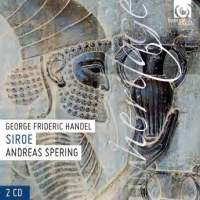Texte paru dans: / Appeared in: |
|
|
Outil de traduction |
|
|
Reviewer: Bernard
Jacobson The labels may have changed—last time around, it was cpo versus Vox—but, like his recording of Imeneo, which I reviewed with some enthusiasm in 27:6, Andreas Spering's new Siroe on Harmonia Mundi comes into direct competition with Rudolph Palmer's earlier version, released in 1991 by Newport Classic. In the present case, honors between the two recordings are more even, so that I fear this is going to be another of those infuriating reviews that refuse to come down firmly on one side or the other.
In arriving at their
performing texts, conductors Spenng and Palmer take quite different tacks.
With unusual and indeed perhaps excessive honesty, Harmonia Mundi bills its
Siroe as an “abridged version.“ This had me worried, but the abridgment
turns out to affect only the long secco recitatives. These are very
substantially reduced in length, but none of the set numbers are omitted or
cut. Palmer, by contrast, excises relatively little from the recitatives,
but omits two arias (Laodice's “Or mi perdo ogni speranza“ at the end of act
I, and Siroe's “Se l'amor tuo mi rendi“ in act III), and also omits the
brief repeat in the da capo of Emira's “Sgombra dell'anima.“
Since the recitatives in this
work are exceptionally fine and dramatically pertinent, the Newport
performance as a whole certainly gains from Palmer's fuller treatment,
especially in view of John Ostendorf's compellingly personal delivery. The
loss, on the other hand, of “Se l'amor“ (which could easily have been
accommodated within the set's three-disc format) is to be regretted. This is
a superb aria, fully representative of Siroe's righteous—not to say
self-righteous—character, and laid out in arresting three-measure phrases
that bring a welcome rhythmic freshness to the score. It is, moreover, quite
superbly sung in the Harmonia Mundi set by the Swedish mezzo Ann Hallenberg,
who was the star of Spering's imeneo cast, and who stands out even more
emphatically in the no less excellent vocal line-up he has brought together
for Siroe. This is a voice of rare beauty and warmth, deployed with absolute
clarity and firmness of line, and a welcome accession to the increasing
ranks of accomplished mezzos that seem to be cropping up these days all over
the place.
Of the other soloists in the
new set, only the Emira, Johanna Stojkovic, is a holdover from Imeneo. She
again sings well, but this time her rival in Palmer's performance, Julianne
Baird, seems to me clearly superior. In addition to all of Baird's familiar
charm and grace, her performance benefits from Palmer's more relaxed
conducting, particularly in “Sgombra dell'anima.“ Here, Spering's taste for
rapid tempos reaches a point where his strings inevitably sound ragged and
the effect of his singer's and players' evident strain is frankly ugly;
Baird and Palmer lose nothing in urgency and gain much in musicality and
poise. Spering's Laodice, Medarse, and Cosroe are all excellent, and the
smaller role of Arasse is well taken. But as Laodice and Medarse, Palmer's
Andrea Matthews and Steven Rickards are as good, perhaps even better, and
though Sebastian Noack's Cosroe may be more fluently and beautifully sung
than John Ostendorf's, it is Ostendorf that brings more character and
intensity to this royal figure: he sounds genuinely conflicted, where Noack
is altogether too youthful and untroubled in tone.
Fast tempos aside, I find
Spering's treatment of the embellishment question also as puzzling as it was
in Imeneo. The da capo sections are fully ornamented—sometimes, indeed, to
excess in the case of one or two cadential flourishes—but Spering is
obviously unconvinced by such testimony as that of Handel's contemporary
Pier Francesco Tosi, who declared in his Observations on the Florid Song
that embellishment should begin in the middle section of an aria, and
proceed to further levels of artistry and intricacy in the da capo. Under
Spering, the opening sections often sound plain to the point of
unstylishness, as does his eschewing of overdotting in the introductory
section of the overture. In all of these respects, Palmer's performance seems to me more convincing. Overall, since Palmer's orchestra plays with considerable polish for him, and the Newport recording is no less well managed than the Harmonia Mundi, I am inclined to think that the earlier version is the one I shall listen to more often in the future. Still, when I do so, well as Palmer's D'Anna Fortunato sings the title role, I shall certainly miss Ann Hallenberg. Her wonderful singing is a very strong factor in the new set's favor, and may serve as consolation for collectors unable to locate a copy of the rather elusive Newport Classic. |
|
|
|
|
|
|
|
|
Cliquez l'un ou l'autre
bouton pour découvrir bien d'autres critiques de CD |
|




